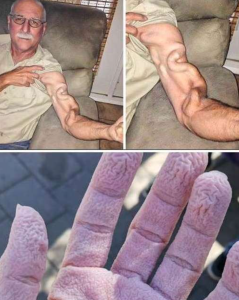The Stretch That Changed Everything: How a Simple Move Uncovered a Silent Threat
It was an ordinary morning, one of those days that begins with the usual routines—coffee brewing in the kitchen, sunlight sneaking through the blinds, and the quiet stretch of muscles waking from sleep. For Daniel Morris, a 43-year-old office manager and father of two, it should have been no different. But on that particular day, what started as a simple stretch ended with a sharp pain in his arm—one that refused to fade.
At first, Daniel thought nothing of it. Perhaps he had slept wrong, pinched a nerve, or strained a muscle in his shoulder while reaching overhead. People stretch all the time and feel little twinges; most go away after a few minutes. But this pain wasn’t like the usual stiffness. It was sudden, piercing, and oddly localized. “It felt like something tore inside,” Daniel recalled. “But I hadn’t even moved fast—I was just stretching like I always do.”
The Pain That Didn’t Leave
For the rest of the morning, the discomfort lingered. Daniel tried rolling his shoulder, massaging the area, even shaking his arm out, but nothing brought relief. As the hours passed, the pain grew worse, radiating down his forearm, accompanied by a tingling sensation in his fingers. By lunchtime, he realized something wasn’t right.
That evening, instead of heading to the gym as he usually did, Daniel went home and rested, hoping sleep would make things better. But the next morning, the pain was still there, sharper now, accompanied by swelling around his upper arm. His wife, alarmed by how pale he looked, urged him to see a doctor immediately.
A Silent and Unexpected Diagnosis
When Daniel arrived at the urgent care clinic, doctors initially suspected a torn muscle or tendon injury. But something didn’t add up. His pain wasn’t just muscular—it came with numbness and visible swelling. Concerned about circulation, the doctor ordered an ultrasound. What they found shocked everyone: Daniel had a blood clot in one of the major veins of his arm.
The condition, known as deep vein thrombosis (DVT), is more commonly associated with legs, particularly after long flights or extended bed rest. But upper-extremity DVT, while rarer, can also occur—sometimes triggered by repetitive arm movement, compression of veins, or even an anatomical quirk that restricts blood flow.
The doctor explained to Daniel that his simple stretch might have aggravated an already vulnerable spot in his vein, dislodging or triggering a clot that had silently been forming. If left untreated, the clot could break free and travel to his lungs, causing a potentially fatal pulmonary embolism.
“I went from thinking I just pulled a muscle to hearing that I could’ve died,” Daniel said. “It was terrifying.”
Hospitalization and Treatment
Daniel was immediately admitted to the hospital. He was started on blood thinners to prevent the clot from growing and to reduce the risk of it breaking off. In addition, he underwent further imaging to ensure no clots had already traveled to his lungs. Thankfully, they hadn’t.
Over the next several days, doctors monitored his condition closely. The swelling began to subside, and his pain slowly improved. But his road to recovery was far from over. He would need to take anticoagulant medication for months, possibly longer, and undergo lifestyle adjustments to prevent future clots.
Understanding the Risks
Daniel’s case highlights a critical yet often overlooked health issue. Blood clots are sometimes called “silent killers” because they can form without obvious warning signs. Many people, like Daniel, mistake the early symptoms for muscle pain or injury.
Risk factors for DVT include:
-
Prolonged sitting or immobility (such as desk jobs or long flights).
-
Family history of clotting disorders.
-
Injury or surgery affecting veins.
-
Certain medications or medical conditions that increase clotting risk.
-
Dehydration and poor circulation.
But as Daniel’s story shows, sometimes the risk comes from something as simple as repetitive motion or an innocent stretch.
The Emotional Impact
For Daniel, the diagnosis was a wake-up call that reshaped how he viewed his health. “I always thought of myself as fairly healthy,” he admitted. “I exercised, I ate okay, I wasn’t overweight. So this came out of nowhere for me.”
The hardest part, he said, was explaining it to his kids. His 12-year-old son, a budding soccer player, couldn’t understand how his strong, active dad could suddenly be “sick from stretching.” His daughter, just 8, cried when she overheard a nurse explaining the dangers of clots.
“It’s one thing to face it yourself,” Daniel reflected. “It’s another to see fear in your children’s eyes. That made me determined to fight through recovery.”
Life After the Clot
Months later, Daniel’s life has changed in subtle but significant ways. He now takes daily medication, goes for regular check-ups, and wears a compression sleeve during long days at the office to help with circulation. He also adopted new habits: standing and stretching every hour, drinking more water, and being mindful of how much time he spends sitting still.
Most importantly, he has become an advocate for awareness. At his workplace, he shared his story during a wellness meeting, urging colleagues not to ignore unusual pains or swelling. “We joke about work injuries being paper cuts or sore backs,” he said, “but sometimes the things you brush off are the ones that can kill you.”
A Broader Lesson
Daniel’s story resonates beyond his personal struggle. It underscores the importance of listening to one’s body. Too often, people dismiss pain as trivial or assume it will go away. But sometimes pain is the body’s way of sending a desperate signal.
Doctors emphasize that prompt medical attention can make the difference between life and death when it comes to blood clots. If Daniel had ignored his symptoms or simply masked the pain with over-the-counter medication, the outcome could have been far more tragic.
The Silver Lining
Looking back, Daniel calls that sharp pain during his morning stretch both a curse and a blessing. “It hurt like nothing I’d felt before,” he said. “But if I hadn’t felt it, I might not be here today.”
For him, the incident became not just a medical crisis but a turning point. He now treasures ordinary moments with his family more deeply—soccer games, Sunday dinners, bedtime stories. He has also grown more vocal about the need to prioritize health before it’s too late.
Final Thoughts
The story of a man who went to stretch and ended up discovering a life-threatening condition is more than just a cautionary tale—it’s a reminder of life’s fragility. Sometimes the smallest, most ordinary actions reveal the biggest hidden dangers.
But it is also a story of resilience, awareness, and second chances. Daniel’s stretch didn’t just change his morning—it changed his life. And in sharing his journey, he hopes others will listen to their bodies, seek help when something feels off, and never dismiss pain as “just a pulled muscle.”
Because sometimes, that pain is the very thing saving your life.


